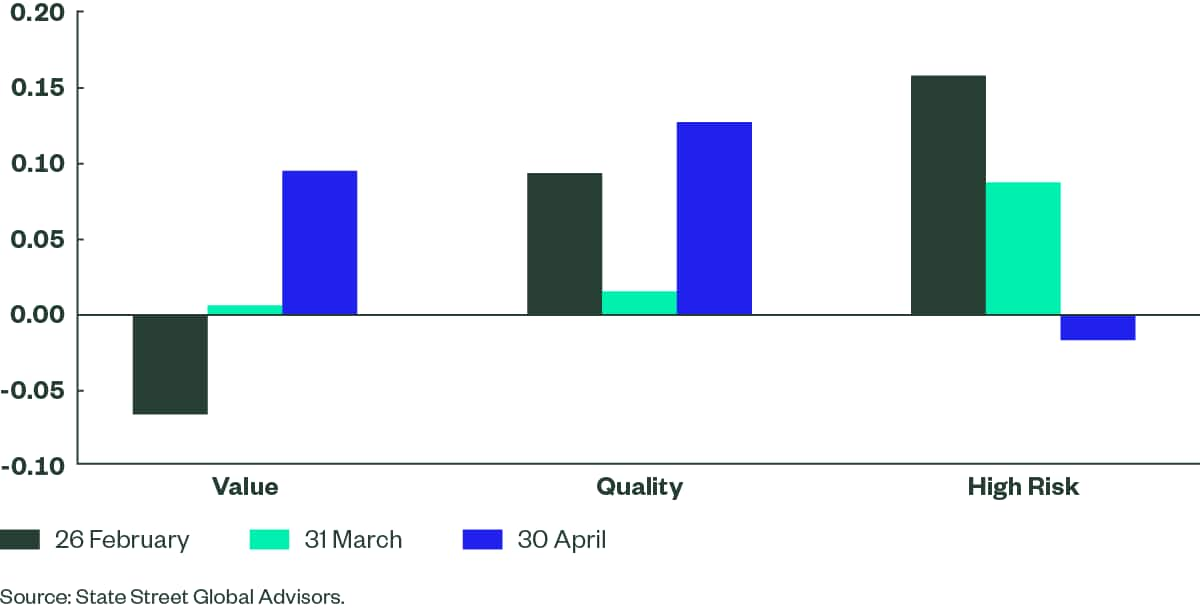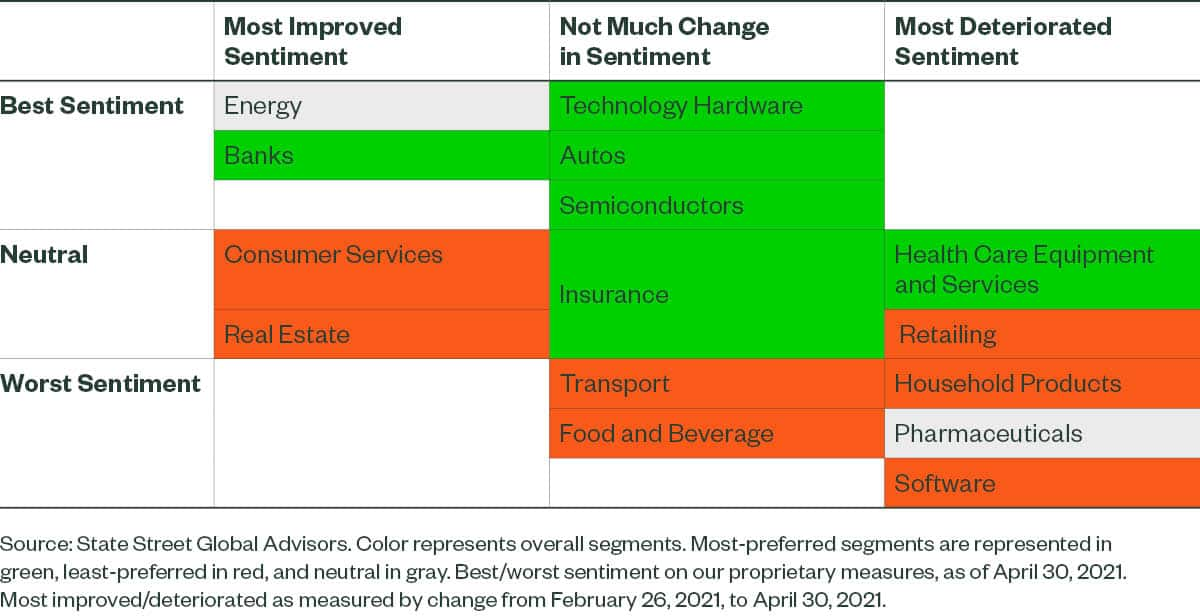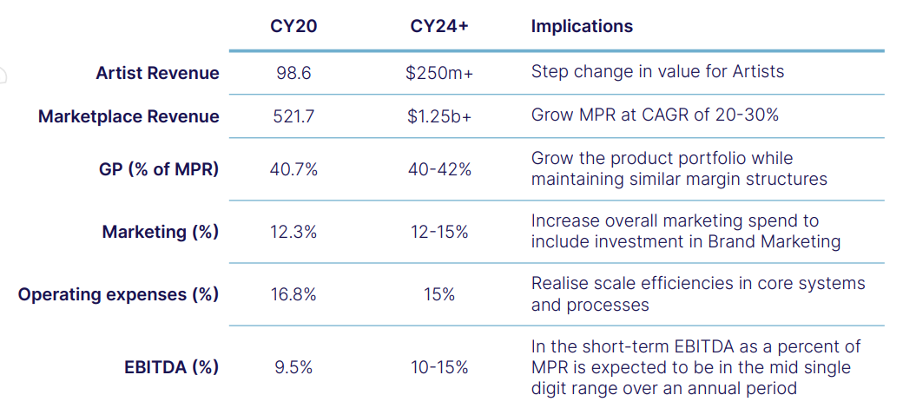NEWS

8 Jun 2021 - Capturing Relative Value in Today's Credit Markets

7 Jun 2021 - Webinar: Cryptocurrencies
|
This week Fund Monitors held a webinar on the subject of cryptocurrencies and were joined by Clint Maddock from Digital Asset Funds Management (DAFM) to try to lift the level of understanding for those interested or intrigued by the opportunity, but unsure where to start or who to listen to. The subject is complex, the risks considerable, but what emerged was that there are also opportunities to achieve returns without taking the levels of directional risk symptomatic of Bitcoin and other digital currencies.
|

7 Jun 2021 - The Six Sectors We Favor Most as Market Sentiment Shifts
|
The Six Sectors We Favor Most as Market Sentiment Shift Olivia Engel, CFA, State Street Global Advisors May 2021
In recent weeks, market sentiment has undeniably shifted away from relatively expensive, high-risk, low-quality stocks. To illustrate the magnitude of this aggregate shift, it's helpful to compare our measures of sentiment with our assessments of value, quality, and risk. The correlation between sentiment and value has shifted from negative to positive over the past two months; the already positive correlation between sentiment and quality has become higher over the same period. At the same time, the correlation between sentiment and high risk has plummeted. Figure 1 shows the extent to which investors recently have been turning their attention toward more reasonably valued, higher-quality, lower-risk stocks. Figure 1 Correlation of Active Quantitative Equity's Proprietary Sentiment Scores with Proprietary Scores for Value, Quality, and Risk That said, in our view not every area of the market with improving sentiment is a good place to invest, and not every segment with deteriorating sentiment should be avoided. Consumer Services and Real Estate both remain unattractive on our measures, despite their improvement in sentiment in recent months. In general, Consumer Services firms still represent very poor value (when taking quality considerations into account). And although many Real Estate companies continue to be of high quality, our signals - which quantitatively analyze the language used in earnings conference calls and in the explanatory notes of financial reports - are concerning. The six market segments we most favor in this environment of shifting sentiment (in no particular order) are Health Care Equipment, Banks, Insurance, Technology Hardware, Autos, and Semiconductors. Our preferences are not always based on improvement in sentiment (see Figure 2). For example, although the broader Health Care sector has experienced heavy deterioration in market sentiment, we still like Health Care Equipment and Services, especially in the US. The language signals from Health Care Equipment and Services companies' conference call transcripts and financial reports are very strong, valuations are reasonable, and quality is high.
Figure 2 AQE's Current Most-Favored and Least-Favored Sectors
Banks have benefited from improving sentiment in recent weeks. While we favor banks overall, that improvement in sentiment is not the sole source of that positive assessment. Drilling down to examine banks by region reveals some important distinctions. European banks have seen a much larger improvement in sentiment than their North American counterparts, but we view European banks as only neutral in attractiveness compared with cheaper North American banks. The same multi-dimensional view informs our negative assessments as well. Sentiment toward real estate stocks across the developed world has improved a lot in recent weeks, but in Europe sentiment toward real estate stocks has actually gotten worse. Our language signals for European real estate names are also very poor. Bottom Line Sentiment has turned to favor attributes we like, including high quality and cheaper valuation. When choosing stocks, however, it's important to weigh all important attributes, including value, quality, and risk - as well as sentiment - in order to avoid simply riding the latest sentiment trends. ssga.com Marketing Communication State Street Global Advisors Worldwide Entities For use in EMEA: The information contained in this communication is not a research recommendation or 'investment research' and is classified as a 'Marketing Communication' in accordance with the Markets in Financial Instruments Directive (2014/65/EU) or applicable Swiss regulation. This means that this marketing communication (a) has not been prepared in accordance with legal requirements designed to promote the independence of investment research (b) is not subject to any prohibition on dealing ahead of the dissemination of investment research. Important Risk Information The information provided does not constitute investment advice and it should not be relied on as such. It should not be considered solicitation to buy or an offer to sell a security. It does not take into account any investor's particular investment objectives, strategies, tax status or investment horizon. You should consult your tax and financial advisor. All information is from SSGA unless otherwise noted and has been obtained from sources believed to be reliable, but its accuracy is not guaranteed. There is no representation or warranty as to the current accuracy, reliability or completeness of, nor liability for, decisions based on such information and it should not be relied on as such. The views expressed are the views of Active Quantitative Equity through May 12, 2021, and are subject to change based on market and other conditions. This document contains certain statements that may be deemed forward-looking statements. Please note that any such statements are not guarantees of any future performance and actual results or developments may differ materially from those projected. Investing involves risk including the risk of loss of principal. Quantitative investing assumes that future performance of a security relative to other securities may be predicted based on historical economic and financial factors, however, any errors in a model used might not be detected until the fund has sustained a loss or reduced performance related to such errors. The trademarks and service marks referenced herein are the property of their respective owners. Third-party data providers make no warranties or representations of any kind relating to the accuracy, completeness or timeliness of the data and have no liability for damages of any kind relating to the use of such data. © 2021 State Street Corporation. Funds operated by this manager: |

4 Jun 2021 - Ivers Steady on Wild Ride During First Three Years
|
Ivers Steady on Wild Ride During First Three Years Prime Value Asset Management 19 May 2021 Richard Ivers, portfolio manager for the Prime Value Emerging Opportunities Fund, has notched up his first three years in charge of the small caps investment fund. Markets have thrown just about everything at investment managers during this time: from flat spots to record highs, and the 'fastest bear market in history', which happened as COVID-19 panicked investment markets. Ivers steered the Prime Value Emerging Opportunities Fund to several key milestones, including being the second best performing Australian equities fund for the 2020 calendar year. He has delivered returns well above the market by prioritising capital protection. "Protecting capital is the most important step for us because if we minimise losses we maximise opportunities. "Every market event creates opportunities. The volatility we have seen in small caps across COVID has provided us with excellent chances to invest in quality companies poised to do well during the recovery and beyond. "But it all starts with a commitment to preserving capital, which means avoiding the speculative stocks and looking through the hype to find real quality." Key numbers for the Prime Value Emerging Opportunities Fund: For the last three years the Prime Value Emerging Opportunities Fund has delivered 20.7% per annum to investors while the index returned 9.1% per annum - this means the Fund has outperformed the index by 11.6% per annum net of fees. During this three years:
The last time the Prime Value Emerging Opportunities Fund underperformed in a falling month was December 2018 - over two years ago. For the year to 30 April 2021 the PVEOF has delivered 54.91%, outperforming the small ordinaries accumulation index by 15.14%, outperforming strongly during 12 months of rising markets. The Fund has delivered 13 consecutive months of positive returns, while the index has had three negative months during that 13. The Prime Value Emerging Opportunities Fund's last negative returning month was March 2020 (during the COVID crash). Performance has been achieved at a lower level of volatility than the market: risk, as measured by volatility, (standard deviation) has been 13.8% below the index. This results in a far superior Sharpe ratio, which measures risk-adjusted returns. Funds operated by this manager: Prime Value Equity Income (Imputation) Fund - Class A, Prime Value Growth Fund - Class A, Prime Value Opportunities Fund, Prime Value Emerging Opportunities Fund |

3 Jun 2021 - Why we sold out of Redbubble
|
Why we sold out of Redbubble Joseph Kim, Portfolio Manager, Montgomery Investment Management 24 May 2021 Most articles we read are about hot stock tips to buy. Occasionally there are articles about "shorting" opportunities, albeit most are directed to sophisticated investors given the risks around shorting (i.e. a potential loss that exceeds your initial investment). Very few articles talk about when to sell. However, it can be just as important to know when to sell as when and what to buy, a key skill in active management. The Redbubble thesis revisited Last year, we highlighted Redbubble as a COVID winner with global aspirations. The business was a significant beneficiary of lockdowns and stimulus payments - with their years and dollars of investment in the artist platform, logistics and supply chains - paying dividends during the global e-commerce boom, especially in their key US markets. The company's execution during this period was stellar as it managed the significant spike in sales volume during the COVID work-from-home period. It was quick to take advantage of the boom in facemask demand - an entirely new product category - which immediately became a major contributor to revenue. The marketplace platform also demonstrated the power of operating leverage, as 96 per cent growth in Revenue delivered 1,028 per cent growth in EBITDA (albeit off a low base) in the December 2020 half. Incremental margins of 25-30 per cent helped drive improved profitability. The Redbubble flywheel helped generate interest during lockdowns, with significant social media interest on Tik Tok and Twitter as well as more mainstream media articles drive users. With all these positive tailwinds, why did we sell out of our holding in Redbubble? In my previous article, the empirical paper "Selling Fast, Buying Slow" referred to three discrepancies between the buying and selling performance of investors:
It is the final point which is relevant in our decision to sell our remaining holding. Assessing earnings risk At Montgomery, we not only focus on the price vs valuation of our investments but also the earnings risks - either higher or lower than market estimates. In many cases, it is these earnings risks that provide significant upside or downside potential relative to the current share price - especially for less mature businesses - as they drive the growth trajectory of future earnings. For Redbubble, the share price faced its first significant road-bump following its DecH20 result released in February. The update revealed some additional costs related to paid acquisition and shipping, as well as reduced gross margins related to promotional activity in the December quarter. Some of these took the market by surprise, and the share price sold off ~15 per cent in the weeks following the release as it too caught up in the broader "rotation" out of e-commerce winners. Earnings risk assessed for March quarter underpins exit thesis The next stock-specific catalyst was the March quarter sales update. With the share price re-based to $5-6/sh after some margin-related earnings downgrades, it was important to assess the likely trajectory of earnings for the June half of FY21. There were two key areas that underpinned our decision to sell prior to Redbubble's March quarter earnings release: Contribution of face masks to revenue While many investors were aware of facemasks being a significant contributor to revenue growth, there were few estimates of the quantum of revenue contribution. After peaking at ~25 per cent of revenue in July, we assessed facemasks had declined to ~5-7 per cent of revenue exiting December. This has a significant impact not only for Redbubble's revenue for March, but also the difficulty in "comping" elevated face-masks sales that were unlikely to be repeated in the September quarter 2021. We also assumed even if COVID did not recede, facemasks were unlikely to be a significant repeat contributor in the key US market due to i) greater competition in masks; and ii) warmer months in the northern hemisphere in conjunction with vaccine roll-out. Impact of currency on revenue growth Given the volatile moves in currency and the US' contribution to revenue, this represented a significant swing factor in our estimates of Redbubble's revenue trajectory. With >70 per cent of Redbubble's revenue from North America and the strength of the AUD vs USD, this represented ~15 per cent headwind to its top line versus the prior comparative period, which we assessed had yet to be fully factored in market earnings estimates. Where we could have been wrong While the decision to sell ahead of its April earnings release may appear to be obvious in hindsight, there were factors which we had to consider where we may be wrong:
All of these factors (and other unexpected positive developments) may have resulted in a higher share price. Despite this, we deemed the risk skew to the earnings and subsequent share price impact was to the downside. Where to given sell-off? With the Redbubble share price having re-based once again (more significantly than we had anticipated) - and with incremental new future sales targets, earnings and profit margins and investment focus areas, it may be worth re-assessing the shares once again as an investment opportunity.
Many of the aspects which initially attracted us to the Redbubble business - the flywheel, operating leverage, investment in supply chains, global reach and aspirations - remains intact. There is also increased awareness of the Redbubble brand given the spike in website viewer traffic and new customers acquired during COVID. It is also clearly a much more valuable company coming out of COVID than it was going in, and should new CEO Michael Ilczynski and the Redbubble team start delivering on its aspirational targets, will likely become more valuable over time. Funds operated by this manager: Montgomery (Private) Fund, Montgomery Alpha Plus Fund, Montgomery Small Companies Fund, The Montgomery Fund |

2 Jun 2021 - Manager Insights: ESG | Longlead Capital Partners
|
ESG investments grew considerably in the Asia-Pacific region in 2020 and there were a number of net-zero emissions targets released by Asia-Pacific countries in late 2020. Dr. Andrew West, Managing Director & Founder of Longlead Capital Partners, speaks about how this has changed the way Longlead look at companies and build their portfolio.
|

31 May 2021 - Manager Insights | Longlead Capital Partners
|
Damen Purcell, COO of Australian Fund Monitors, speaks with Dr. Andrew West, Managing Director and Founder at Longlead Capital Partners. Andrew discusses the structural growth opportunities Longlead is looking at and shares his views on how the rotation to value in global markets has affected Longlead's investment universe. The Longlead Pan-Asian Absolute Return Fund is an equity long/short fund investing in the Asia Pacific region. The Fund started in December 2020 and has risen +5.22% CYTD.
|

27 May 2021 - Australian Private Equity Well Positioned to Outperform
|
Australian Private Equity Well Positioned to Outperform Michael Tobin, Vantage Asset Management 25 May 2021 With Australia now emerging from its first recession in 29 years as a result of the slowing economy caused by the COVID-19 restrictions in 2020, it is timely to compare the historical performance of the Australian & New Zealand Private Equity market across all time frames, to the performance of those Private Equity funds that were established during, or otherwise invested across, previous recessionary periods. Summary statistics provided by AVCAL & Cambridge Associates reveal that the median and upper quartile net returns from Private Equity funds formed in Australia and New Zealand, between 1997 and 2018, focused on the later expansion and buyout financing stage, in which Vantage funds invest, was 11.1% p.a. and 20.3% p.a. respectively. These robust returns demonstrate Private Equity's ability to consistently outperform public markets as the return on the S&P ASX 200 Accumulation Index over the corresponding period was only 8.4% p.a.1. However, during periods of economic contraction, the performance of Private Equity was even more pronounced. Utilising data provided by Preqin (2020) 2, Vantage conducted an analysis of the investment returns delivered by Private Equity Funds during the recessionary periods following the "dot-com crash" in 2000 and the Global Financial Crisis (GFC) of 2008 to 2010. Australian and New Zealand Private Equity funds, focused on investing in the lower to mid-market segment, investing during and up to 2 years following these events generated median and upper quartile net returns of 19.6% p.a. and 45.0% p.a. respectively, significantly outperforming the public market comparables during these periods. WEIGHTED AVERAGE NET IRR % PERFORMANCE OF AUSTRALIAN & NEW ZEALAND PRIVATE EQUITY FUNDS The reason for this outperformance is due to a number of factors which include an increase in opportunities, less competition from listed and trade purchasers and an ultimate decrease in purchase multiples. Vantage's underlying managers' report that purchase multiples have followed a similar downward trajectory to that seen following the dot-com crash and the GFC, providing an increase in the number of attractive investment opportunities. As a result, it is likely that Private Equity funds investing during and following this recessionary period of 2020 - 2023 will more likely outperform historical returns, due to lower purchase multiples combined with the low interest rate environment and ample deployable capital available to be invested. A number of academic papers have analysed and reported on Private Equity's resilience versus non-Private Equity backed peers during past economic downturns. Research conducted by Wilson et la. (2012) 3, from a data set of 14 million financial records, found that Private Equity backed businesses in the United Kingdom during the period 1995 - 2010, experienced significantly positive growth, relative to peers that were non-Private Equity backed throughout the 2008 crisis. Further highlighting Private Equity's resilience during the GFC period, A recent Stanford Business School study, titled "Private Equity and Financial Fragility During the Crisis" by Bernstein, Lerner & Mezzanotti (2017) 4, confirmed that Private Equity backed companies are significantly more resilient and can act as an economic stabiliser during a recession. In the study, Private Equity lead companies were found to be less likely to face financial constraints during an economic downturn such as the GFC, allowing them to grow and increase market share versus their peers throughout the same period. Arguably the current economic contraction has signified the beginning of a new cycle in financial markets and the end of a prolonged period of asset inflation and increasing acquisition multiples. As a result, there will be an increase in attractive investment opportunities for Vantage's underlying Private Equity managers to invest capital at lower than historical valuation multiples, throughout the second half of the calendar year 2020 and into 2021. This re-rating of asset prices and Private Equity's ability to consistently outperform during and following recessionary periods, will ultimately deliver Vantage Fund investors with superior risk adjusted returns over the term of each Vantage Fund. References
Past performance is not necessarily indicative of future performance. Funds operated by this manager: |

26 May 2021 - Webinar Invitation | Cryptocurrencies
 |
|
|
Thursday, June 03, 2021 4:30 PM AEST Webinar - Cryptocurrencies
Interest in Bitcoin and other crypto currencies has accelerated recently in large part due to media coverage, and human nature which dictates that a relatively small outlay which leads to a massive payoff is seen as a reasonable "bet" - somewhat like buying a lottery ticket, but probably with better odds. That doesn't help the majority of people who're attracted by the risk/reward payoff, but either don't know where to start, or even if they did, don't believe they have the skills, expertise or time to enter the market. As a result we have organised a webinar to be held on Thursday June 3rd at 4:30 to try to clarify what to many is the unknown world of crypto currencies and for those - believers and disbelievers alike - who'd like to know more but perhaps didn't know where to start, or want to understand how to avoid the risks.
Time: 04:30 PM AEST Date: Thursday the 3rd of June, 2021
We look forward to seeing you there! |
|
|
Speakers |
|
 |
Clint Maddock |
| CIO, Digital Asset Management | |
| Clint is founder of Sydney based Digital Asset Funds Management (DAFM), and CIO of their newly launched Digital Asset Fund. Clint heads DAFM's team of over 20 financial markets and software professionals and has over 17 years experience trading complex derivative products with an impressive CV that includes studying Aerospace Engineering before co-founding Tibra, a high frequency trading operation, in 2006. | |
 |
Chris Gosselin |
| CEO, Australian Fund Monitors | |
| Australian Fund Monitors Pty Ltd was established in October 2006 to provide an information service to investors interested in the Australian Absolute Return sector. By providing an "eyes and ears" information and analysis service, both investors and Fund Managers are able to compare different funds and investment strategies using a common format and consistent analysis tools. As Founder and CEO, Chris has over 30 years experience in the Financial Services industry, including managing Macquarie Equities' and HSBC James Capel's Melbourne offices prior to establishing InfoChoice Ltd in 1993. | |
|
|
|

25 May 2021 - Are we in a commodities supercycle?
|
Are we in a commodities supercycle? Tom Stevenson, Investment Director, Fidelity International 5th May 2021 There's nothing like a big round number to concentrate the mind. Investors, in particular, have a tendency to get excited about arbitrary price points with an abundance of zeroes. Think the 1999 best-seller 'Dow 36,000' (we're still waiting but not for long, I suspect). Last week's big round number was 10,000 - the price in (US) dollars for a tonne of copper. It was the first time the metal, which is used in everything from kettles to electric vehicles and wind turbines, had fetched that price since the peak of the last industrial metals upswing in 2011. When you consider that you could have bought a tonne of copper for US$4,300 a year ago, the recent rise is quite something. It is hardly surprising that talk of a commodities boom is picking up. And not just any old rally; what's getting investors excited is the prospect of a commodities supercycle. Most industries are cyclical to an extent, but commodities are more so than most because the price of metals, crops and energy are closely tied to real day to day supply and demand. The price of a share can be sustained by hopes for future growth in earnings, but the cost of a tonne of copper reflects the balance of buyers and sellers today. This means that commodities are always moving in mini bull and bear markets. Rising demand and constrained supply pushes prices higher and that, in turn, creates the oversupply that brings the market back into balance. A supercycle is different. It is always driven by some kind of structural change in which demand is transformed over a period of many years, and usually all around the world at the same time. The mass production of motor cars in the early part of the last century, and then the growth of aviation, fundamentally changed the supply/demand dynamic for oil, for example. Commodity supercycles are not that common, but when they kick in they last for years. There have probably only been four proper ones in the past 150 years. The first was triggered by American industrialisation and urbanisation, fuelled by the US's railway boom and accelerated by the First World War's demand for armaments. The causes of the other three are well-known: the post-war recovery in Europe and Japan; the 1970s oil shock, boosted by Lyndon Johnson's Wars on Poverty and in Vietnam, and the space race; and China's rapid growth after it joined the World Trade Organisation in 2000. So, the big question today is whether the recent price signals, from copper (which has doubled in a year), iron ore, nickel, zinc and other metals, indicate a temporary upswing as the world emerges from the Covid pandemic or the start of something more substantial. The answer to that question may well be one of the most important for investors today. It's easy to make the case for a short-term bull market in commodities. The economic data around the world in recent weeks has surprised economists if not stock market investors who identified the possibility of a V-shaped recovery in activity a year ago. Coupled with short-term supply interruptions due to the pandemic, and longer-term constraints thanks to a decade of falling prices, it's no surprise that prices should have bolted in recent months. What's more interesting, however, is the potential for that all-important multi-decade shift in demand. And for that you need look no further than the twin drivers of Joe Biden's transformational spending programme and the energy transition that has the potential to absorb however many trillions of dollars the world's big-spending governments want to print. A third of Biden's so-called American Jobs Plan is earmarked for transport infrastructure and electric vehicles. China, too, has decided that electric vehicles will be the mainstream option within 15 years. Here in Europe, time has already been called on the internal combustion engine over the next decade or so. By 2040, Wood Mackenzie forecasts, there could be 300 million electric vehicles on the world's roads. In 2019 there were 5 million. And that is just cars. Factor in green energy generation, let alone the once in a hundred years rebuilding of crumbling infrastructure on both sides of the Atlantic, and the demand for green metals like copper, nickel, aluminium and platinum is likely to soar. Glencore, the commodities trader and mining company, thinks demand for copper could double in 30 years. Importantly, capital investment in new capacity is well below what is needed to meet that growth in demand. Of the more than 200 big copper deposits to have been found in the past three decades, only a handful have come in the last 10 years. Only 80 or so are now in production or have been closed. It takes years to develop a copper mine and in recent years shareholders have encouraged the payment of dividends over preparing for a future boom. So, how might investors position themselves for the supercycle ahead? The simplest and cheapest way is via a commodities-focused exchange traded fund. There are plenty of different flavours but a broad-based exposure to metals and energy makes sense. To turbo-charge returns in the event of a prolonged upswing, investing directly in commodity producers is a better idea. With relatively fixed costs, miners' and oil companies' earnings will rise more quickly than the price of their underlying resources. The other advantage of investing in commodity-related shares is that they can also deliver a high and sustainable dividend income. The combination of price gains and re-invested dividends over the duration of a typical supercycle might point you towards your own big round number. Funds operated by this manager: Fidelity Australian Equities Fund, Fidelity Future Leaders Fund, Fidelity India Fund, Fidelity Global Emerging Markets Fund, Fidelity China Fund, Fidelity Asia Fund
|



